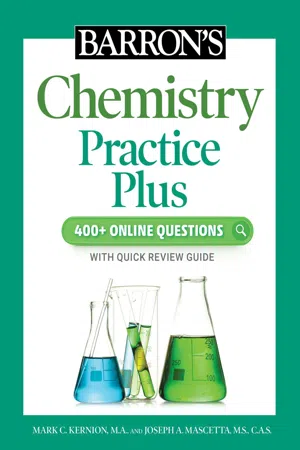Chemistry
Properties of Solids
The properties of solids include definite shape and volume, strong intermolecular forces, and low compressibility. Solids have a fixed arrangement of particles in a crystalline or amorphous structure, and they exhibit a characteristic melting point. Additionally, solids have high density and are not easily compressible due to the close packing of particles.
Written by Perlego with AI-assistance
Related key terms
Related key terms
1 of 4
Related key terms
1 of 3
5 Key excerpts on "Properties of Solids"
- R. E. Smallman, R J Bishop(Authors)
- 1999(Publication Date)
- Butterworth-Heinemann(Publisher)
Chapter 6The physical properties of materials
6.1 Introduction
The ways in which any material interacts and responds to various forms of energy are of prime interest to scientists and, in the context of engineering, provide the essential base for design and innovation. The energy acting on a material may derive from force fields (gravitational, electric, magnetic), electromagnetic radiation (heat, light, X-rays), high-energy particles, etc. The responses of a material, generally referred to as its physical properties, are governed by the structural arrangement of atoms/ions/molecules in the material. The theme of the structure/property relation which has run through previous chapters is developed further. Special attention will be given to the diffusion of atoms/ions within materials because of the importance of thermal behaviour during manufacture and service. In this brief examination, which will range from density to superconductivity, the most important physical properties of materials are considered.6.2 Density
This property, defined as the mass per unit volume of a material, increases regularly with increasing atomic numbers in each sub-group. The reciprocal of the density is the specific volume ν , while the product of ν and the relative atomic mass W is known as the atomic volume . The density may be determined by the usual ‘immersion’ method, but it is instructive to show how X-rays can be used. For example, a powder photograph may give the lattice parameter of an fcc metal, say copper, as 0.36 nm. Then 1/(3.6 × 10−10 )3 or 2.14 × 1028 cells of this size (0.36 nm) are found in a cube 1 m edge length. The total number of atoms in 1 m3 is then 4 × 2.14 × 1028 = 8.56 × 1028 since an fcc cell contains four atoms. Furthermore, the mass of a copper atom is 63.57 times the mass of a hydrogen atom (which is 1.63 × 10−24 g) so that the mass of 1 m1 of copper, i.e. the density, is 8.56 × 1028 × 63.57 × 1.63 × 10−24 = 8900 kg m−3- Mark Kernion, Joseph A. Mascetta(Authors)
- 2022(Publication Date)
- Barrons Educational Services(Publisher)
CHAPTER 7Liquids, Solids, and Phase Changes
Learning Objectives In this chapter, you will learn how to:Describe the states of matter (solids, liquids, and gases).Describe and compare the important Properties of Solids, liquids, and gases.Describe the various types of phase change.Analyze a phase diagram.Explain the use of liquid water as a common solvent.Solve solubility and concentration problems.Solve colligative property problems in a qualitative manner.Describe the continuum of water mixtures, including solutions, colloids, and suspensions.Liquids and solids are considered condensed phases of matter. By itself, this is a significant differentiation from the phase of matter called a gas. But there are many other important characteristics that distinguish solids and liquids from gases as well as those that distinguish solids from liquids. Macroscopically (i.e., in a form visible to the naked eye), there are several ways to differentiate solids, liquids, and gases. But in order to understand the states of matter well, and in addition how they change from one to another, it is important to be able to envision these phases from a mind’s-eye perspective that takes into account what they are like on an atomic/molecular level.General Characteristics of Solids, Liquids, and Gases
Macroscopically, solids are seen as rigid materials that maintain their shape independent of the container they are in. This rigidity is what differentiates them from liquids and gases, which can both be described as fluid because they can flow and take on the shape of their containers. Although liquids and solids are different with regard to their visible shapes, they are similar with regard to their measurable volumes. Liquids, unlike gases, do not assume the volume of their container. Gases spread out to take up the volume of the container in which they find themselves. Solids act like liquids: their volume is not dependent upon or determined by the container they occupy. Table 7.1- eBook - ePub
- Richard A. Storey, Ingvar Ymén, Richard A. Storey, Ingvar Ymén(Authors)
- 2011(Publication Date)
- Wiley-Blackwell(Publisher)
Chapter 1 Introduction to the Solid State – Physical Properties and Processes Ingvar Ymén AstraZeneca R&D, Södertälje, Sweden 1.1 IntroductionPharmaceutical substances consist of organic molecules alone, or in combination with metal cations (metal salts), organic cations, organic or inorganic anions, neutral organic molecules (co-crystals) or solvent molecules (solvates). Even though some are salts, these have little resemblance with inorganic salts, the typical properties of which include high melting points, high hardness and strong ionic bonding. In fact, pharmaceutical substances, as salts or not, generally have similar properties, which are dominated by the presence of the organic molecules and their typical, weak intermolecular interactions. Crystals formed by organic substances are usually referred to as molecular crystals (Kitaigorodsky 1973) and it is the properties of this type of molecules that will be referred to when talking about the properties of pharmaceutical substances. In the following the physical states of a pure pharmaceutical substance will be discussed with reference to Figure 1.1 where the approximate areas of existence as a function of temperature are shown.1.1.1 The Gas/Vapour and Liquid StatesFigure 1.1 Different possible physical states of a pharmaceutical substance as a function of temperature; it is assumed that the pressure is constant at 1 atmosphereA gas consists of molecules, moving independently of each other, but occasionally colliding with each other or with the vessel in which it is contained. The collisions make up the gas pressure and the more collisions the higher is the pressure. A gas containing small, point-like molecules with negligible molecular interactions is called ideal. For such a gas:where p = pressure, V = volume, n = the number of moles, T = temperature and R = the gas constant. Most gases are nonideal because their molecules are not pointlike and they interact to some extent. Gases at high temperatures are closest to ideal and the deviation from ideality increases closer to the point of condensation. In a mixture of ideal gases each gas will exert a pressure, which is proportional to the amount of that gas. The total pressure is the sum of the individual pressures so that for n different ideal gas molecules: - eBook - ePub
- Alan Everett, C. M. H Barritt(Authors)
- 2014(Publication Date)
- Routledge(Publisher)
1 General properties Some properties, which relate to certain materials only, are considered in other chapters. Properties which relate to materials generally are dealt with in this chapter, ie:- Density and specific gravity
- Strength
- Optical properties
- Electrical properties
- Thermal properties and insulation
- Acoustic properties
- Deformations
- Deterioration
- Appearance
1.1 Density and specific gravity
BS 648 Schedule of weights of building materials is a useful reference for calculation purposes. Table 1.1 gives densities for many materials in kg/m3 , and others are given at the appropriate points in the text.Specific gravity is a ratio of the density of a substance at a given temperature to the density of water at 4°C.1.2 Strength
Materials must be capable of safely supporting their own weight and any applied loads without distortion which would reduce the efficiency of a structure, or be unsightly. Strength properties are defined on this page and values are given for a range of materials on pages 150—51.When a material is said to be 'strong' it is its strength in tension which is usually referred to, but it is often necessary to know its strength properties in compression, shear and torsion. Also, strength properties vary with the rate and frequency of loading and, in non-homogeneous materials, with the direction of loading. Strength properties are further influenced by the moisture content of materials such as timber and the temperature of materials such as plastics. Absorbent materials are usually tested when wet to allow for loss of strength in that state.Materials which are subjected to a force are said to be stressed and the change in shape is known as strain (cause and effect). In elastic materials up to an elastic limit - eBook - ePub
Active Pharmaceutical Ingredient Manufacturing
Nondestructive Creation
- Girish K. Malhotra(Author)
- 2022(Publication Date)
- De Gruyter(Publisher)
18 ]. Each has to be dealt accordingly.3.4 Solid
Chemicals that are solid at room temperature can be handled in their natural state but compared to liquids, they present handling challenges. Solids are easier to handle in solutions. Solubility of the solid in different solvents at different temperatures is extremely useful information. Most of the time, solubility information is not available. It would have to be generated in the laboratory. Solids can be charged to the reactors and would necessitate proper solid handling measures. These depend on the process. Economics and solid toxicity dictate the method of handling and respective investment. Other alternate to handle solid is the molten form, but as discussed later, melting point, product demand, supply, logistics, equipment design, and economics are major considerations for this route.Solids that are formed during the reaction could be filtered, if they are a product and purified. If further processing to a product is needed, proper unit operations and processes have to be used to convert to the desired product. Physical properties such as melting point and solubility come into play. Since most of the reactions are at elevated temperatures and solvents are present, viscosity of the mixture seldom interferes the reaction progress.3.5 Gas
Gases are best handled in their compressed liquid form. They can be handled as solution but, discussed later, they have their own challenges.3.6 Material handling
Melting, boiling, and freezing points determine the physical state of each chemical. At room temperature, each chemical comes in either of the three states: solid, liquid, or gas. This sets how each material will be handled for batch and continuous processes. Irrespective of the state of the chemical and quantity used, it is absolutely necessary that each chemical, intermediate and by-product be handled with respect. Toxicity of many chemicals is documented [21 , 22 , 23 , 24
Index pages curate the most relevant extracts from our library of academic textbooks. They’ve been created using an in-house natural language model (NLM), each adding context and meaning to key research topics.
Explore more topic indexes
Explore more topic indexes
1 of 6
Explore more topic indexes
1 of 4




